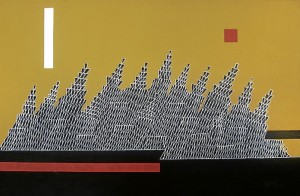
There are few artists who truly define the ethos of Modernism better than National Artist Arturo Luz.
Distilling what appears to be figurations into their essential lines, shapes and forms—and often against the alluring simplicity of a minimalist backdrop—Luz has pioneered and defined Philippine abstract minimalism. Transforming mystical cityscapes and temples into blocks, circles, colors and lines, Luz is a firm stalwart of the international movement for minimalist abstraction—in the same vein as the likes of Gerardo Rueda, Isamu Noguchi and Fernando Zobel.
In celebration of National Arts Month, Galerie Joaquin is presenting “Essential Luz.” This will be composed of 30 works done by the master from 1997-2004. The exhibit starts with an opening reception on Feb. 27, 6:30 p.m., and runs until March 14.
The works come from the private collection of a noted businessman and his wife who have one of the most extensive collections of Arturo Luz artworks.
It is a homecoming of sorts for Luz. Since 2006, four of his most important and major shows have been held at Galerie Joaquin. It is a continuation of the series of major Luz shows the Galerie had hosted in the past since 2006.
The collector couple, with the support of Luz and in cooperation with Galerie Joaquin, have come up with this exhibit to help in the education about the works of the master thereby helping in the campaign against fakes and forgeries.
“Essential Luz” has representatives from Luz’s classic series, including his acclaimed cityscapes. “Cities of the Past,” for instance, presents the mysticism and grandeur of a city long since gone.
Luz, in a Cultural Center of the Philippines documentary, recounts that much of his cityscapes and temples have been influenced by the allure of lost cities that he’d encountered in his travels—Borobudur in Indonesia, Angkor Wat in Cambodia.
“Essential Luz” presents a comprehensive survey of works of the master from “Imaginary Landscapes,” “Palitana Temples,” “Rajasthan,” “White Temples” to “Cities of the Past.”
Luz was born in Manila on Nov. 20, 1926. After studies at the University of Santo Tomas, he received a scholarship at the California College of Arts and Crafts in Oakland. He continued his education at the Brooklyn Museum Art School in New York in 1950 and at the Academie de la Grande Chaumiere in Paris in 1951.
Galerie Joaquin Main is at the corner of P. Guevarra Street and Montessori Lane in San Juan City. Call 7239418 or 632-7239253. E-mail info@galeriejoaquin.com. Visit www.galeriejoaquin.com.